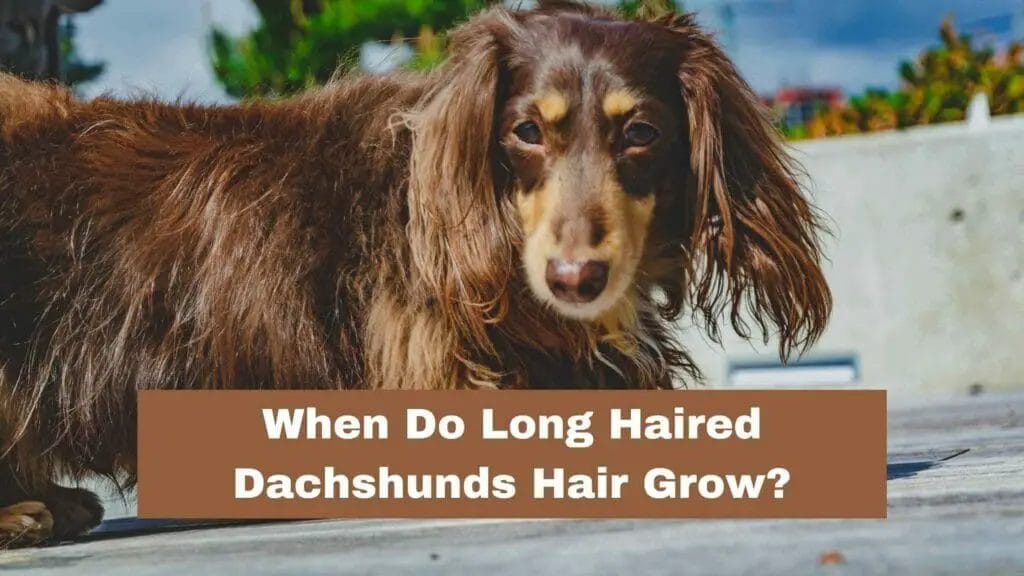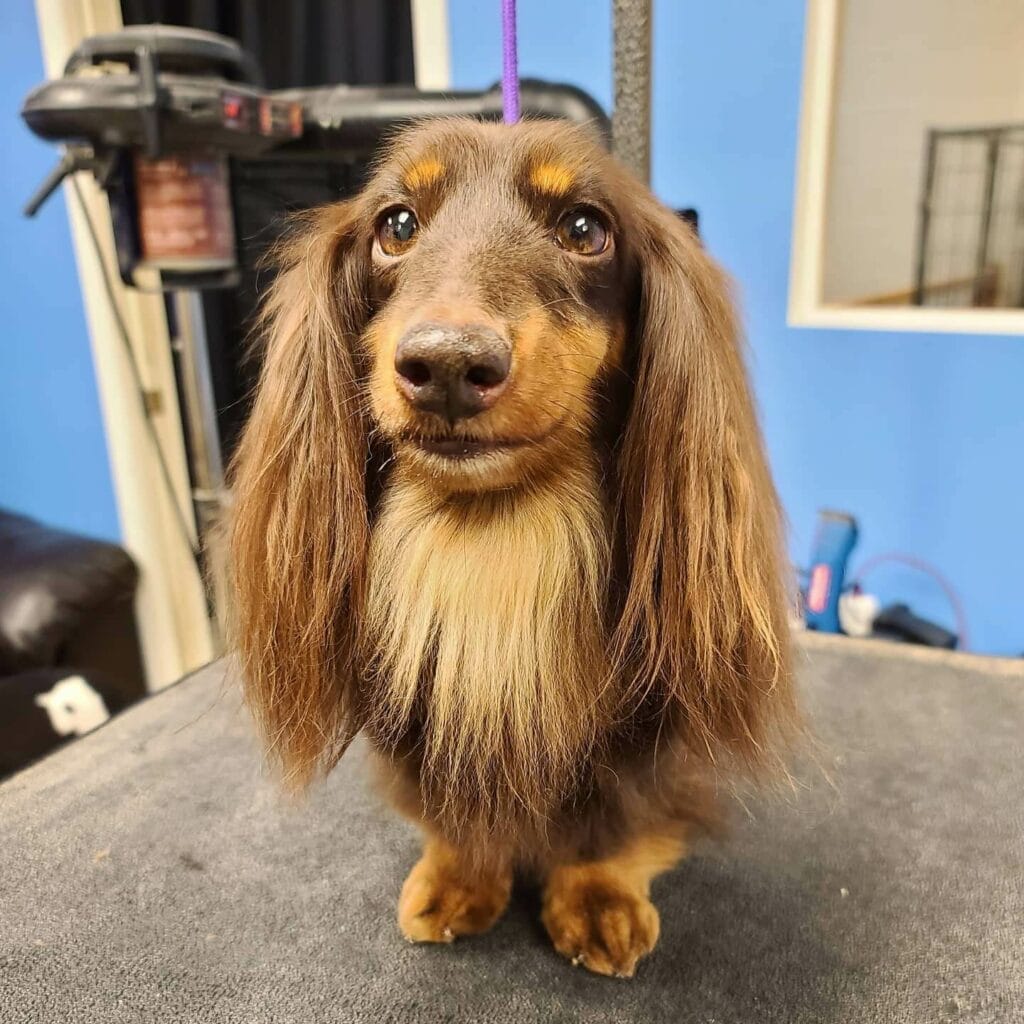
Long-haired Dachshunds are a unique and striking breed, admired for their lush coats that set them apart from other types of dachshunds. But when do long haired dachshunds hair grow, and how can you properly maintain their beautiful locks?
In this blog post, we’ll take a deep dive into the world of these stunning dogs and explore their hair growth timeline, factors affecting their coat development, ways to identify long haired Dachshunds, and essential grooming tips.
Long Haired Dachshunds Hair Growth Timeline
The hair of a Long Haired Dachshund starts growing at four weeks and fully develops within 18 months to two years.
Hair Growth Starts At 4 Weeks Of Age
I confess my love for these adorable, energetic dogs only grew stronger when I discovered the long-haired variety. From personal experience, it’s fascinating to witness how their hair grows over time.
Though born with short fuzz like any other fur baby, long-haired dachshunds’ coat gradually gets fuller in no time. If you ever have the chance to visit the breeder (or perhaps adopt a puppy yourself), don’t be surprised if you notice distinct changes in their fur every week or so.
Their cute ears become adorned with feathery tufts while their bodies flaunt luxurious coats that’ll surely make heads turn during daily walks around your neighborhood.
Full Coat Grows In 18 Months To 2 Years
I’ve learned that patience is key when it comes to waiting for your puppy’s full coat to grow in. Typically, this can take anywhere between 18 months and 2 years, with most seeing significant growth at around the 3-6 month mark.
During this period of hair growth in our Dachshunds’ lives, we may marvel at their transformation from adorable puppies to elegant adult dogs. You’ll watch your long-haired doxie slowly develop longer fur around his ears, chest, stomach area, and tail over time – the hallmark characteristics of this breed type.
Tip: It's important not to rush into trimming their hair before they're fully grown because doing so can actually harm their developing skin.

Factors Affecting Long Haired Dachshunds Hair Growth
There are several factors that can affect the growth of a long-haired Dachshund’s hair, including genetics, nutrition, and environmental factors.
Genetics
I’ve come to learn that genetics play a significant role in determining the hair growth of our furry friends. It’s essential to be aware that not all long-haired Dachshunds will develop their luxurious coats at the same pace or even share similar coat types.
After doing some research and talking to experienced breeders, it turns out that these differences in coat types can be traced back to the specific combination of genes passed down from their ancestors.
Thus, if you’re curious about how your puppy’s coat may develop over time or what type of grooming they’ll require in the future (like those specialized grooming sessions crucial for maintaining their thick manes), consider taking a closer look at your pup’s lineage and ancestry.
Nutrition
Proper nutrition is key to maintaining healthy hair growth. Nutrition plays a significant role in the development of your pup’s coat.
Feeding your furry friend high-quality dog food with balanced nutrients like protein, fat, and vitamins can help promote strong hair growth. In addition to regular grooming and exercise, provide them with ample opportunity for clean water intake to avoid dehydration which could lead to dry skin and slow down hair growth.
As always, regularly consult with your vet as they can recommend a diet tailored specifically for their breed and unique needs, such as omega-3 supplements to promote shiny coats.
Environmental Factors
The environment in which a long-haired Dachshund puppy grows, and lives can affect the growth of its hair. The quality of air, water, and food available to them plays an essential role in hair growth.
Pups living in healthy environments with fresh air, clean water, and a balanced diet tend to grow their coats faster than those that don’t. Exposure to extreme weather conditions may also slow down or even stop hair growth temporarily.
For example, during hot summers or cold winters, puppies might experience temporary shedding as their bodies try to regulate temperature by reducing fur thickness.
To maintain optimal health for your long-haired Dachshund’s coat and prevent any environmental factors from affecting it negatively requires consistent grooming habits of brushing and bathing regularly using high-quality products specially made for dogs’ delicate skin.
How To Identify Long Haired Dachshunds
To identify a long haired Dachshund, look for hair on their ears, chest, stomach, and tail or consult with a reputable breeder who can help you spot the differences between the three coat varieties.
Observe Hair On Ears, Chest, Stomach, And Tail
One way to identify a long-haired Dachshund is by observing the hair on specific parts of their body. Here are some areas to pay attention to:
- Ears: Long-haired Dachshunds have hair that hangs down around their ears, creating a feathery appearance.
- Chest: Along with the hair on their ears, long-haired Dachshunds have thick, flowing hair on their chest.
- Stomach: The fur on a long-haired Dachshund’s stomach can be wavy or straight and will typically be longer than the fur on the rest of their body.
- Tail: Like their ears, long-haired Dachshunds have hair that extends from their tail, creating a sort of plume behind them.
Observing these areas can give you an idea of whether or not a puppy is long-haired and what type of coat they may have as an adult. It’s important to note that while these observations can be helpful, it’s always best to look at the puppy’s parents or consult with a reputable breeder for more information.
Look At The Puppy’s Parents
When considering a long-haired Dachshund puppy, it’s important to take a close look at the parents of the pup. By examining their parents, you can get an idea of what your puppy may look like when they reach adulthood.
For example, if both parents have fluffy fur around their ears and chest, it’s likely that your long-haired Dachshund will have similar features as well. Additionally, if both parents are friendly and social dogs, there is a good chance that your new puppy will be outgoing too.
Consult With A Reputable Breeder
When looking to adopt a long-haired Dachshund, it’s important to consult with a reputable breeder. A good breeder will have a wealth of knowledge about the breed and can provide you with valuable insight into your new pet’s temperament, grooming needs, and potential health issues.
Conclusion
In conclusion, long-haired Dachshunds have a unique hair growth pattern that starts at around 4 weeks of age and takes 18 months to 2 years for their full coat to grow in.
A puppy’s fur should not be trimmed until fully grown, as it may harm the developing skin. Long-haired Dachshunds require specialized grooming to avoid being swallowed by their thick manes and maintain healthy skin.
Knowing how to identify a long-haired Dachshund is crucial, so you can provide the proper care needed for this type of breed.
